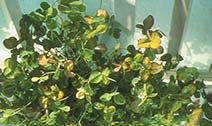Boron Deficiency in Clovers
Clover crops require adequate boron for nodulation and nitrogen fixation, as well as proper root growth. Clover seed production appears to be particularly sensitive to boron deficiency. Crops that do not show any obvious symptoms or whose growth is only slightly improved by boron applications can respond dramatically to boron applications in the seed production year.
Boron is needed for proper pollen germination and for pollen tube growth. There is also evidence that increased nectar secretion (and possibly flower modification) brought about by boron application can increase the numbers of bees working over clover flowers and thereby improve seed set.
Different clover varieties exhibit different boron deficiency symptoms.
Alsike clover {Trifolium hybridum}
The main symptoms of boron deficiency in alsike clover include:
- Stunted plants
- Leaflets with interveinal yellowing and a bronzed appearance with the veins remaining dark green
- Malformed leaves at the shoot tips
- Short flower stems with few flower heads
In addition, plants may have poor pollen germination and tube growth when either pollen or pistil is boron deficient.
Burr clover {Medicago hispida}
When burr clover is boron deficient, the plants are much reduced in size. In addition, the young leaves near the growing points are twisted, thickened and curled at the leaf margins.
Crimson clover {Trifolium incarnatum}
Together with
alfalfa and berseem clover (
T. alexandrinum), crimson clover is rated as being very sensitive to boron deficiency. The symptoms of boron deficiency are very similar to those reported in other clovers, namely stunting and eventual malformation of young leaves and shoots, with red and yellow tints developing on leaves.
Red clover {Trifolium pratense}
If boron deficiency occurs on very young red clover seedlings, the first trifoliate leaf will be small and imperfectly shaped. Young leaves will be small and distorted, and eventually the growing points die. The leaves develop red and purple tints (sometimes following a general chlorosis). The colors are usually more pronounced on the under surface of the leaf. Leaf margins may become necrotic.
Red tints may develop on older unifoliate leaves. On older plants, growth will gradually become stunted with the stems often swollen and thickened near the growing points.
Subterranean clover {Trifolium subterraneum}
Boron deficiency symptoms in subterranean clover first appear on the young leaves, which are chlorotic, stunted, and distorted. The older leaves usually show some intense purple or red pigmentation along the margins.
Stem growth is reduced. Seed set and quality may be impaired leading to poor regeneration.
Sweet clover {Melilotus spp.}
Sweet clover leaves turn red and later yellow when the plant is deficient in boron. Growth is also slow and stunted.
White clover {Trifolium repens}
 If boron deficiency occurs on very young white clover seedlings, the first trifoliate leaf is small and imperfectly shaped. Red tints may develop on older, unifoliate leaves.
If boron deficiency occurs on very young white clover seedlings, the first trifoliate leaf is small and imperfectly shaped. Red tints may develop on older, unifoliate leaves.
On older plants, growth will gradually become stunted with the stems often swollen and thickened near the growing points. Young leaves are small and distorted, and eventually the growing points die. The leaves develop red and purple tints (sometimes following a general chlorosis). The colors are usually more pronounced on the under-surface of the leaf.
Finally, leaf margins may become necrotic.